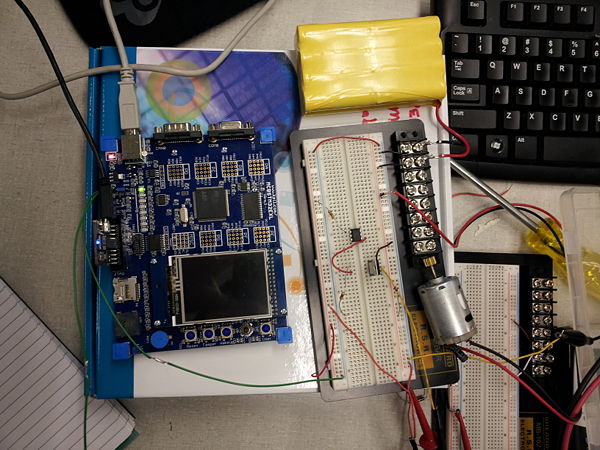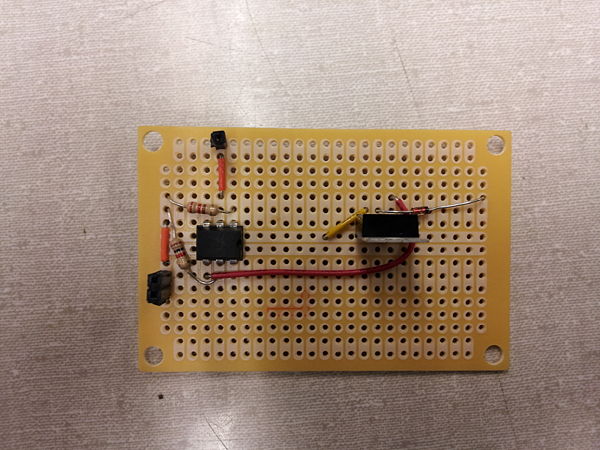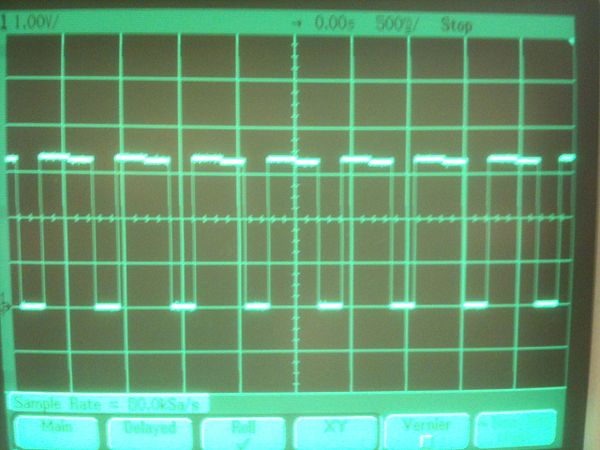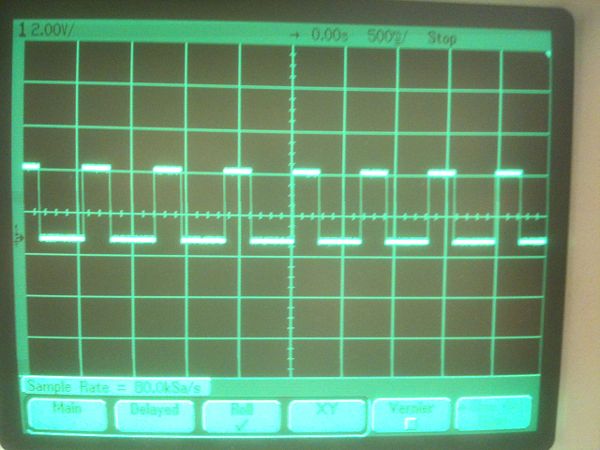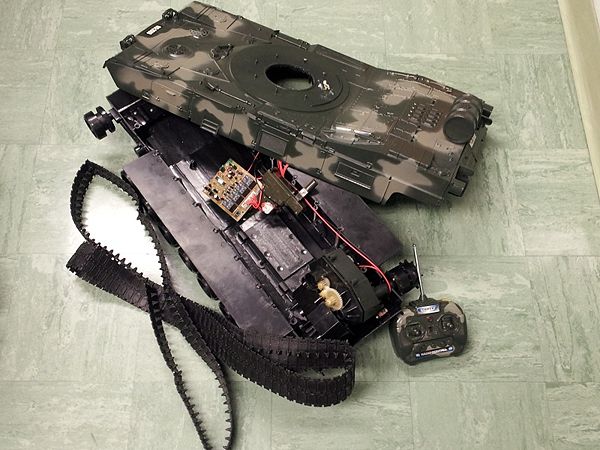| (6 intermediate revisions by the same user not shown) | |||
| Line 1: | Line 1: | ||
=Topics from Meeting (November 3)= | =Topics from Meeting (November 3)= | ||
| − | Attendees: Jason Holmes, Scott Stack, Kin Chin Chua, Michael Piercy | + | Attendees: Jason Holmes, Scott Stack, Kin Chin Chua, Michael Piercy, Chris Romanoff |
Group worked to get the PWM driving the DC motor circuit to work. Also finished design review topics. | Group worked to get the PWM driving the DC motor circuit to work. Also finished design review topics. | ||
| + | <br><br> | ||
| + | <b>Design Review Topics</b> | ||
| + | *Objective: | ||
| + | **Collaborate with Hong Kong University of Science and Technology to develop a vehicle control system using the internet. | ||
| + | **Each team is building a vehicle that is capable of receiving commands from the internet via WI-FI. Each team is also creating their own website that is capable of controlling both vehicles. This way, we will have to work with Hong Kong to develop a protocol that will enable the websites to communicate with both vehicles. | ||
| + | **Applications of this technology: | ||
| + | ***Virtual Presence – having a physical presence in a room across the world and being able to interact with that environment. Useful in areas like business meetings etc… | ||
| + | ***Remote Exploration – Being able to log into a website and remotely survey an area without being physically present. Display information such as GPS location, orientation (accelerometer, temperature, etc… to the user. | ||
| + | |||
| + | *Completed Tasks | ||
| + | **hold teleconference to communicate with HKUST on deciding the protocols, processors, vehicle control options, vehicle platform. | ||
| + | **designed a block diagram to explain the basic idea of the control system. | ||
| + | ***include the diagram in slides | ||
| + | **created a poster for and participated in VIP poster session. | ||
| + | ***include the poster in slides | ||
| + | **did research and chose the appropriate parts such as: | ||
| + | ***vehicle platform (tank) | ||
| + | ****big enough to be able to get everything mounted inside the vehicle | ||
| + | ****low speed so that it will not crash | ||
| + | ****low cost | ||
| + | ***microcontroller board (Keil MCBSTM32EXL) | ||
| + | ****Arm M3 Cortex processor | ||
| + | ****sufficient documentations and software libraries | ||
| + | ****includes all the peripherals we need such as A/D, PWM, SPI, UARTS and so on | ||
| + | ***wireless transceiver () | ||
| + | ***IR sensors | ||
| + | ****to detect the objects in certain range (20 cm to 150 cm) | ||
| + | ****to prevent crash | ||
| + | ***pushbuttons | ||
| + | ****due to the IR sensors only functioning above 20 cm, it prevent crash into objects in the range of 20 cm. | ||
| + | **tried simple programs on the microcontroller board | ||
| + | **picture taken | ||
| + | **made a list of everything that needs to be interfaced with the processor and which kind of interface each one needs. | ||
| + | ***refer to rhea (Oct. 25 documentation) | ||
| + | **dissembled the tank and found out how the control works | ||
| + | **attach picture | ||
| + | **tried designing a separate circuit to control the motor by using the chosen microcontroller board. | ||
| + | |||
| + | *Future Tasks | ||
| + | **Wireless Transceiver interfacing | ||
| + | ***Acquire the wireless transceiver | ||
| + | ***Successfully configure it to interface it with a development board to send/receive data to some source. | ||
| + | **Camera interfacing | ||
| + | ***Acquire the camera and materials | ||
| + | ***Figure out how read the image data coming from the camera | ||
| + | ***Interface to it with a development board and use the LCD on the development board to display the camera image. | ||
| + | **Peripheral interfacing and Website Development | ||
| + | ***Write code to initialize the I/O ports to make use of the IR voltages and pushbutton signals. | ||
| + | ***Interface to the motors on the tank and write code to control them | ||
| + | ***Begin development of a website that will be able to communicate with the vehicle. | ||
| + | |||
[[Image:PWMMotorBreadboard.jpg|600px|thumb|left]] | [[Image:PWMMotorBreadboard.jpg|600px|thumb|left]] | ||
[[Image:PWMMotorCircuit.jpg|600px|thumb|left]] | [[Image:PWMMotorCircuit.jpg|600px|thumb|left]] | ||
| + | |||
| + | [[Image:PWM_Scope1.jpg|600px|thumb|left]] | ||
| + | |||
| + | [[Image:PWM_Scope2.jpg|600px|thumb|left]] | ||
| + | |||
| + | [[Image:TankApart.jpg|600px|thumb|left]] | ||
| + | |||
[[ LRVC Discussions|Back to LRVC Discussions]] | [[ LRVC Discussions|Back to LRVC Discussions]] | ||
Latest revision as of 11:03, 4 November 2011
Topics from Meeting (November 3)
Attendees: Jason Holmes, Scott Stack, Kin Chin Chua, Michael Piercy, Chris Romanoff
Group worked to get the PWM driving the DC motor circuit to work. Also finished design review topics.
Design Review Topics
- Objective:
- Collaborate with Hong Kong University of Science and Technology to develop a vehicle control system using the internet.
- Each team is building a vehicle that is capable of receiving commands from the internet via WI-FI. Each team is also creating their own website that is capable of controlling both vehicles. This way, we will have to work with Hong Kong to develop a protocol that will enable the websites to communicate with both vehicles.
- Applications of this technology:
- Virtual Presence – having a physical presence in a room across the world and being able to interact with that environment. Useful in areas like business meetings etc…
- Remote Exploration – Being able to log into a website and remotely survey an area without being physically present. Display information such as GPS location, orientation (accelerometer, temperature, etc… to the user.
- Completed Tasks
- hold teleconference to communicate with HKUST on deciding the protocols, processors, vehicle control options, vehicle platform.
- designed a block diagram to explain the basic idea of the control system.
- include the diagram in slides
- created a poster for and participated in VIP poster session.
- include the poster in slides
- did research and chose the appropriate parts such as:
- vehicle platform (tank)
- big enough to be able to get everything mounted inside the vehicle
- low speed so that it will not crash
- low cost
- microcontroller board (Keil MCBSTM32EXL)
- Arm M3 Cortex processor
- sufficient documentations and software libraries
- includes all the peripherals we need such as A/D, PWM, SPI, UARTS and so on
- wireless transceiver ()
- IR sensors
- to detect the objects in certain range (20 cm to 150 cm)
- to prevent crash
- pushbuttons
- due to the IR sensors only functioning above 20 cm, it prevent crash into objects in the range of 20 cm.
- vehicle platform (tank)
- tried simple programs on the microcontroller board
- picture taken
- made a list of everything that needs to be interfaced with the processor and which kind of interface each one needs.
- refer to rhea (Oct. 25 documentation)
- dissembled the tank and found out how the control works
- attach picture
- tried designing a separate circuit to control the motor by using the chosen microcontroller board.
- Future Tasks
- Wireless Transceiver interfacing
- Acquire the wireless transceiver
- Successfully configure it to interface it with a development board to send/receive data to some source.
- Camera interfacing
- Acquire the camera and materials
- Figure out how read the image data coming from the camera
- Interface to it with a development board and use the LCD on the development board to display the camera image.
- Peripheral interfacing and Website Development
- Write code to initialize the I/O ports to make use of the IR voltages and pushbutton signals.
- Interface to the motors on the tank and write code to control them
- Begin development of a website that will be able to communicate with the vehicle.
- Wireless Transceiver interfacing

